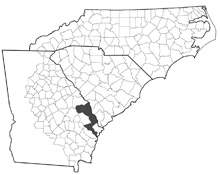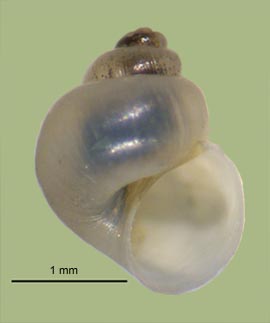> Habitat & Distribution
This minute hydrobiid was described as endemic to the Ogeechee River and Buckhead Creek (a large tributary of the Ogeechee) in the coastal plain of Georgia (map below.) Animals are typically collected by washing rocks into a white bucket (Thompson 1977). Marstonia halcyon demonstrates non-apparent rarity in our 15-state study area, FWGNA incidence rank I-3*.
> Ecology & Life History
Hydrobiids seem to be rather nonspecific grazers of small particles (Dillon 2000: 94-97). They are typically dioecious, the males being characterized by a penis that arises from the neck. Females attach single eggs in spare, hemispherical capsules to solid substrates (Hershler 1994). No specific life history data are as yet available for M. halcyon.
> Taxonomy & Systematics
Like Spilochlamys, Notogillia, and Floridobia, the genus Marstonia belongs to the subfamily Nymphophilinae of the Hydrobiidae (ss), males being characterized by a lobe-shaped penis (or verge) with  surficial glandular patterns (Kabat and Hershler 1993, Hershler et al. 2003, Thompson 2004). The penis of M. halcyon has been figured by Thompson (1977).
surficial glandular patterns (Kabat and Hershler 1993, Hershler et al. 2003, Thompson 2004). The penis of M. halcyon has been figured by Thompson (1977).
Of the three nominal Marstonia species inhabiting Georgia Atlantic drainages, M. halcyon is the most distinctive by virtue of its thinner and more delicate shell. Marstonia halcyon is, however, strikingly similar to M. castor (Thompson 1977) of the Flint drainage. The three individual M. halcyon, M. agarhecta, and M. castor mtDNA sequences examined by Hershler and colleagues (2003) were not substantially different. Divergence did appear substantial between the three Marstonia sequences and a single sequence from Floridobia floridana, however. Sequences from M. halycon, M. agarhecta, and F. floridana also made cameo appearances (as outgroups) in the western study of Liu & Hershler (2005). See under M. agarhecta for additional systematic notes.
> Maps and Supplementary Resources
- Marstonia distribution in Atlantic drainages (2023)
- Marstonia distribution in Georgia and the Florida panhandle (2025)
> Essays
- Conservation-biased oversampling of the endemic hydrobiid fauna of Georgia was featured in my blog post of 19Mar12, "Toward the Scientific Ranking of Conservation Status - Part III."
- Earlier versions of this website, online until August of 2016, adopted the large, broadly-inclusive concept of the Hydrobiidae (sl) following Kabat & Hershler (1993). More recently the FWGNA project has shifted to the Wilke et al. (2013) classification system, distinguishing a much smaller Hydrobiidae (ss) and elevating many hydrobioid taxa previously ranked as subfamilies to the full family level. For more details, see The Classification of the Hydrobioids.
> References
Baker, F.C. (1926) Nomenclatural notes on American fresh water Mollusca. Transactions of the Wisconsin Academy of Sciences, Arts, and Letters 22:193-205.
Dillon, R. T., Jr. (2000) The Ecology of Freshwater Molluscs. Cambridge, Cambridge University Press. 509 pp.
Hershler, R. (1994) A review of the North American freshwater snail genus Pyrgulopsis (Hydrobiidae). Smithsonian Contributions to Zoology 1994; 0(554):1-115.
Hershler, R., H. Liu, and F.G. Thompson (2003) Phylogenetic relationships of North American nymphophiline gastropods based on mitochondrial DNA sequences. Zoologica Scripta 32:357-366.
Hershler, R., and F.G. Thompson (1987) North American Hydrobiidae (Gastropoda: Rissoacea): redescription and systematic relationships of Tryonia Stimpson, 1865 and Pyrgulopsis Call and Pilsbry, 1886. The Nautilus 101:25-32.
Kabat, A.R., and R. Hershler (1993) The prosobranch snail family Hydrobiidae (Gastropoda: Rissooidea): review of classification and supraspecific taxa. Smithsonian Contributions to Zoology 547:1-94.
Liu, H., and R. Hershler (2005) Molecular systematics and radiation of western North American nympholine gastropods. Molecular Phylogenetics and Evolution 34:284-298.
Thompson, F.G. (1969) Some hydrobiid snails from Georgia and Florida. Quarterly Journal of the Florida Academy of Sciences 32:241-265.
Thompson, F.G. (1977) The hydrobiid snail genus Marstonia. Bulletin of the Florida State Museum 21(3):113-158.
Thompson, F.G. (2004) An identification manual for the freshwater snails of Florida.
Thompson, F. G. & R. Hershler (2002) Two genera of North American freshwater snails: Marstonia Baker, 1926, resurrected to generic status, and Floridobia, new genus (Prosobranchia: Hydrobiidae: Nymphophilinae). The Veliger 45: 269 - 271.
Wilke T., Haase M., Hershler R., Liu H-P., Misof B., Ponder W. (2013) Pushing short DNA fragments to the limit: Phylogenetic relationships of hydrobioid gastropods (Caenogastropoda: Rissooidea). Molecular Phylogenetics and Evolution 66: 715 736.








